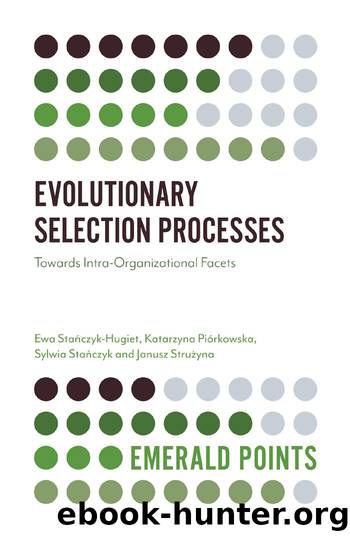Evolutionary Selection Processes by Stańczyk-Hugiet Ewa;Piórkowska Katarzyna;Stańczyk Sylwia;Strużyna Janusz;

Author:Stańczyk-Hugiet, Ewa;Piórkowska, Katarzyna;Stańczyk, Sylwia;Strużyna, Janusz;
Language: eng
Format: epub
Publisher: Emerald Publishing Limited
Published: 2019-01-25T00:00:00+00:00
CHAPTER 4
INTEGRATING SELECTION AND STRATEGIC FIT
4.1. STRATEGIC FIT
Evolutionary logic is based on the principles of the VSR and focuses on explaining the process of change in terms of the interactions between these three abstract mechanisms. Finally, only these elements, which best fit the environment, survive. It indicates that elements are selected according to some criteria of fitness appropriate to the environments (Powell & Wakeley, 2003).
The strategic management literature proposes a number of explanations on the concept of strategic fit (Hughes, Powell, Chung, & Mellahi, 2017). Strategic fit, so important in the strategy process, designates the need for adjustment between the organization and its surrounding. It is a specific type of adjustment that is also a precondition for an organizationâs survival. Strategic management expresses the significance of adjustment and discusses the effectiveness of strategies by investigating the adjustment of the organizational strategy to the general or industry environment and by observing strategic change (Huffman, 2001, p. 14). Environmental complexity calls more and more for a new perception of the organizational âfit.â The utility of organizational fitness and the ability to learn are constantly growing in importance (Voelpel, Leibold, Tekie, & Von Krogh, 2005).
The concept of organizational fitness seems to fit well in the argument about organizational flexibility in the organizational learning perspective. The analytical approach, traditionally employed in the process of strategic management, is no longer satisfactory. Successful management should be oriented toward exploiting and exploring future possibilities. Constant learning as a way to improve operation can only facilitate this (Baird, Su, & Tung, 2017). An organization may be able to change and respond at the operational level to achieve operational flexibility. Nonetheless, operational flexibility is only one characteristic of the organizational system. To survive, the organization needs strategic flexibility (Matthyssens, Pauwels, & Vandenbempt, 2005).
Strategy has a fitness function. As accepted by organizations, it determines specific kinds of activities and specific kinds of resources to acquire, as well as specific kinds of relations to establish. Organizations attain distinctiveness, or heterogeneity, which supports their divergent behaviors and provides a variety of competitive dynamics through the choices made in the terms of strategy (Mathews, 2002).
Evolutionary research, in particular, has noted that a fitness of organization is relative, or it is constructed in the way that âcoevolvesâ among organizations (Fombrun & Astley, 1983). Evolutionary academics have noted that an organizationâs fitness is the best salient feature when comparing it to other organizations (Hannan & Freeman, 1984; Nelson & Winter, 1982). There is a supposition that selection processes favor relatively more fit organizations and that the fit becomes a source of organizational survival. However, the survivors would not have learned from the competition because the fit may be a result of luck, for example. That situation evidences the Red Queen effect resulting from a lack of organizational learning (Barnett & Hansen, 1996). The selection mechanism operates herein along with learning as well. Hereafter, the tradition of organizational evolution should be attentive for the fact that both selection and learning operate in the way that cultural evolution does (e.
Download
This site does not store any files on its server. We only index and link to content provided by other sites. Please contact the content providers to delete copyright contents if any and email us, we'll remove relevant links or contents immediately.
Hit Refresh by Satya Nadella(8983)
The Compound Effect by Darren Hardy(8719)
Change Your Questions, Change Your Life by Marilee Adams(7546)
Nudge - Improving Decisions about Health, Wealth, and Happiness by Thaler Sunstein(7443)
The Black Swan by Nassim Nicholas Taleb(6925)
Deep Work by Cal Newport(6793)
Daring Greatly by Brene Brown(6356)
Rich Dad Poor Dad by Robert T. Kiyosaki(6300)
Principles: Life and Work by Ray Dalio(6102)
Man-made Catastrophes and Risk Information Concealment by Dmitry Chernov & Didier Sornette(5862)
Playing to Win_ How Strategy Really Works by A.G. Lafley & Roger L. Martin(5705)
Digital Minimalism by Cal Newport;(5570)
Big Magic: Creative Living Beyond Fear by Elizabeth Gilbert(5541)
The Myth of the Strong Leader by Archie Brown(5358)
The Slight Edge by Jeff Olson(5309)
Discipline Equals Freedom by Jocko Willink(5229)
The Motivation Myth by Jeff Haden(5113)
Stone's Rules by Roger Stone(4981)
The Laws of Human Nature by Robert Greene(4909)
